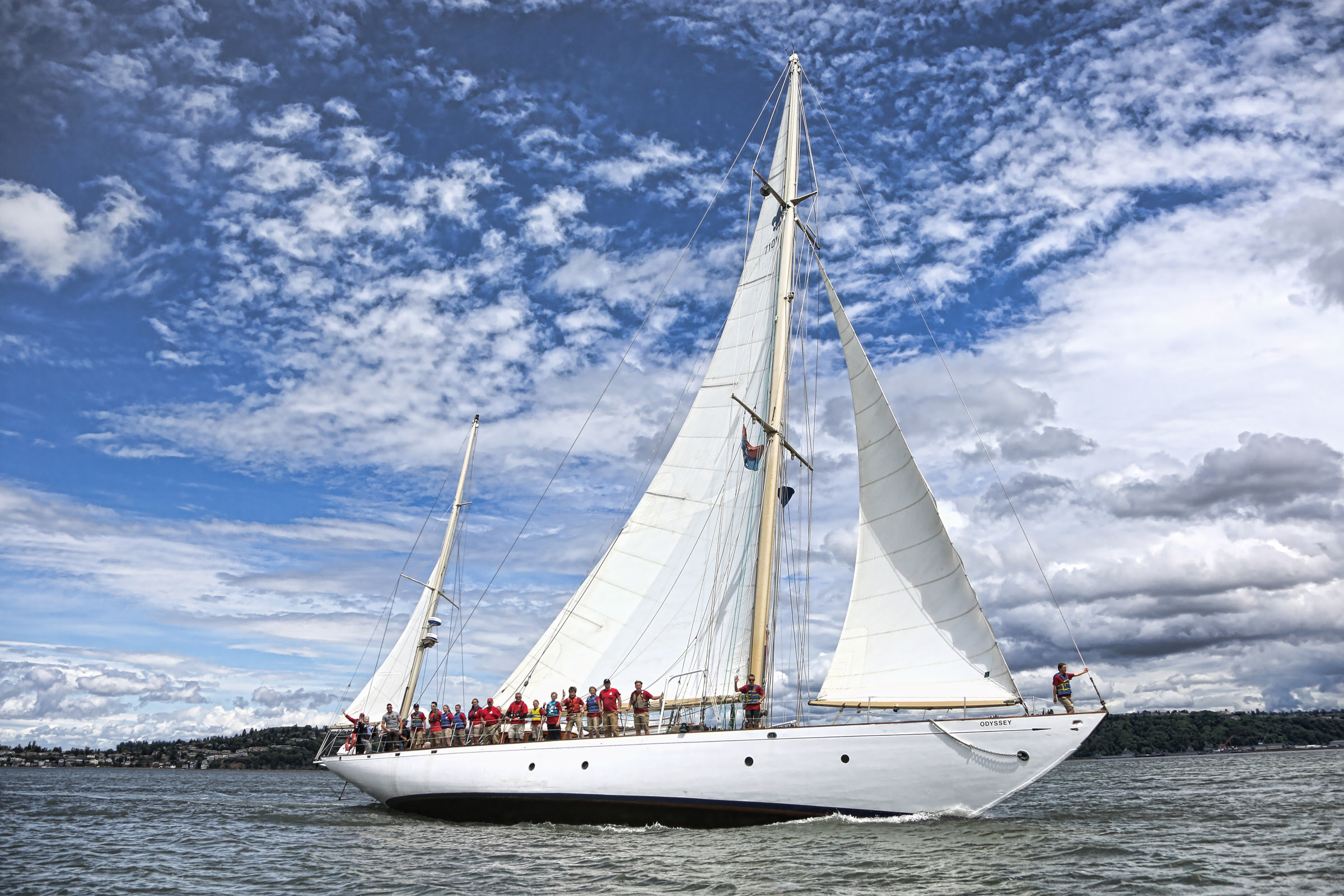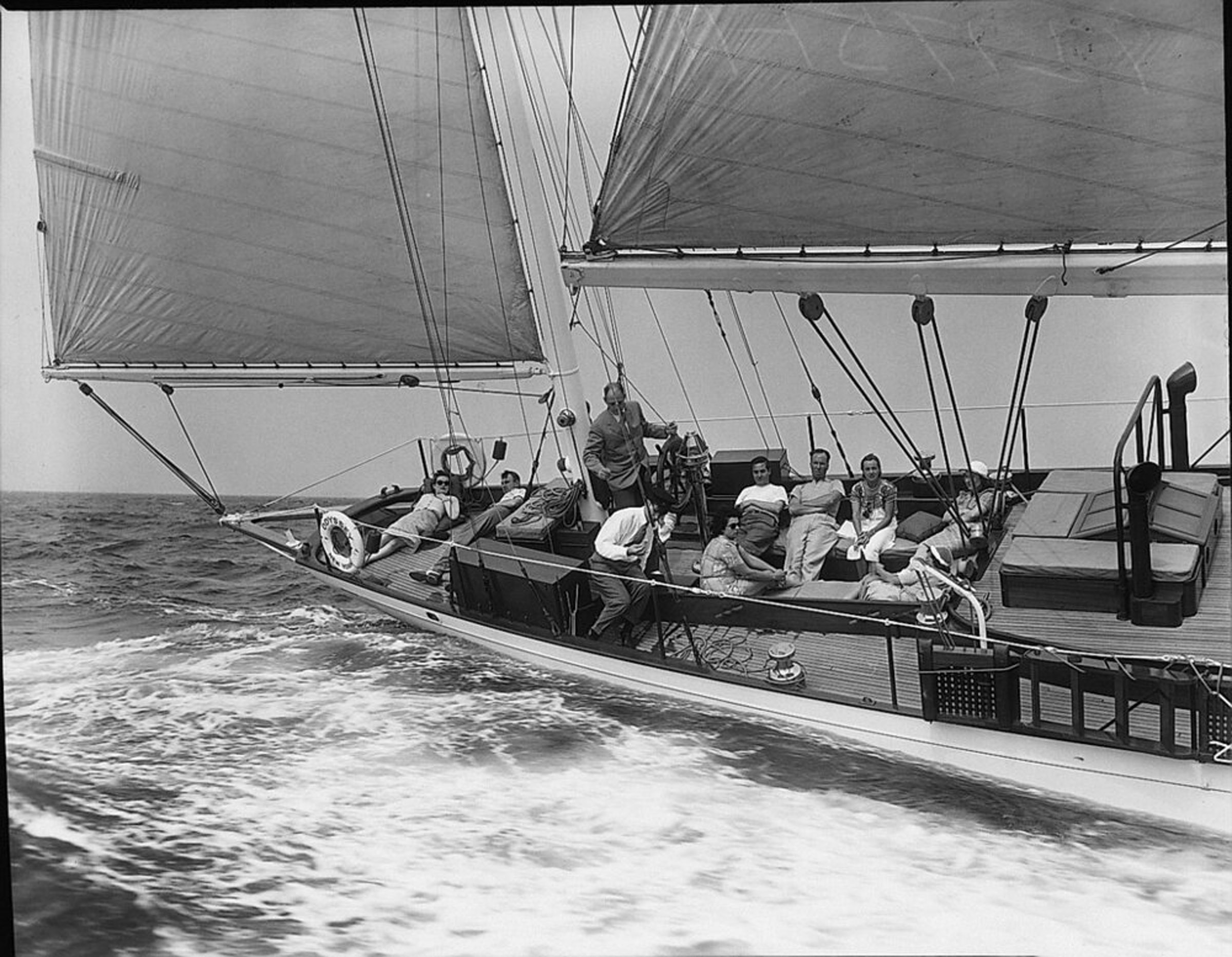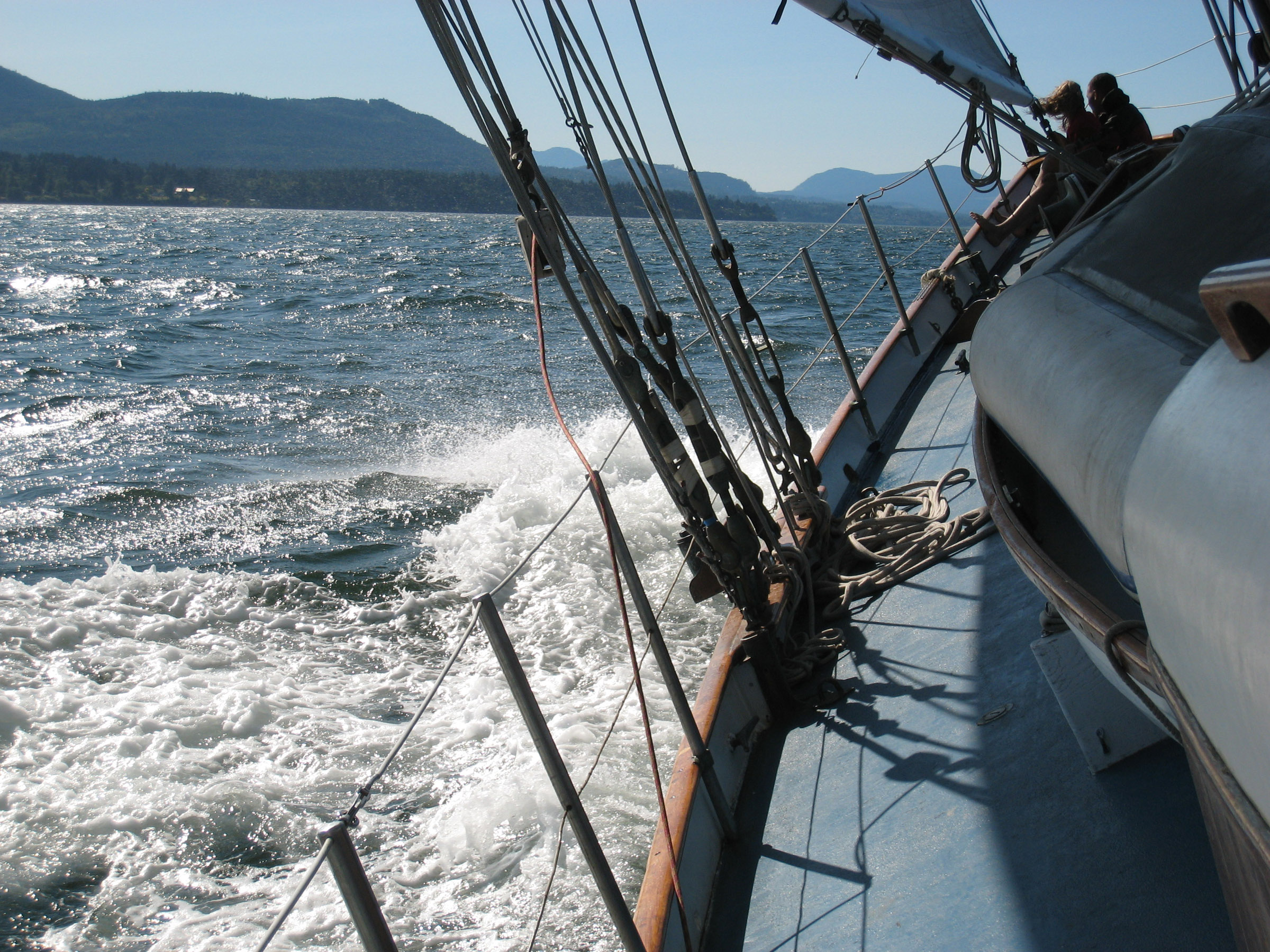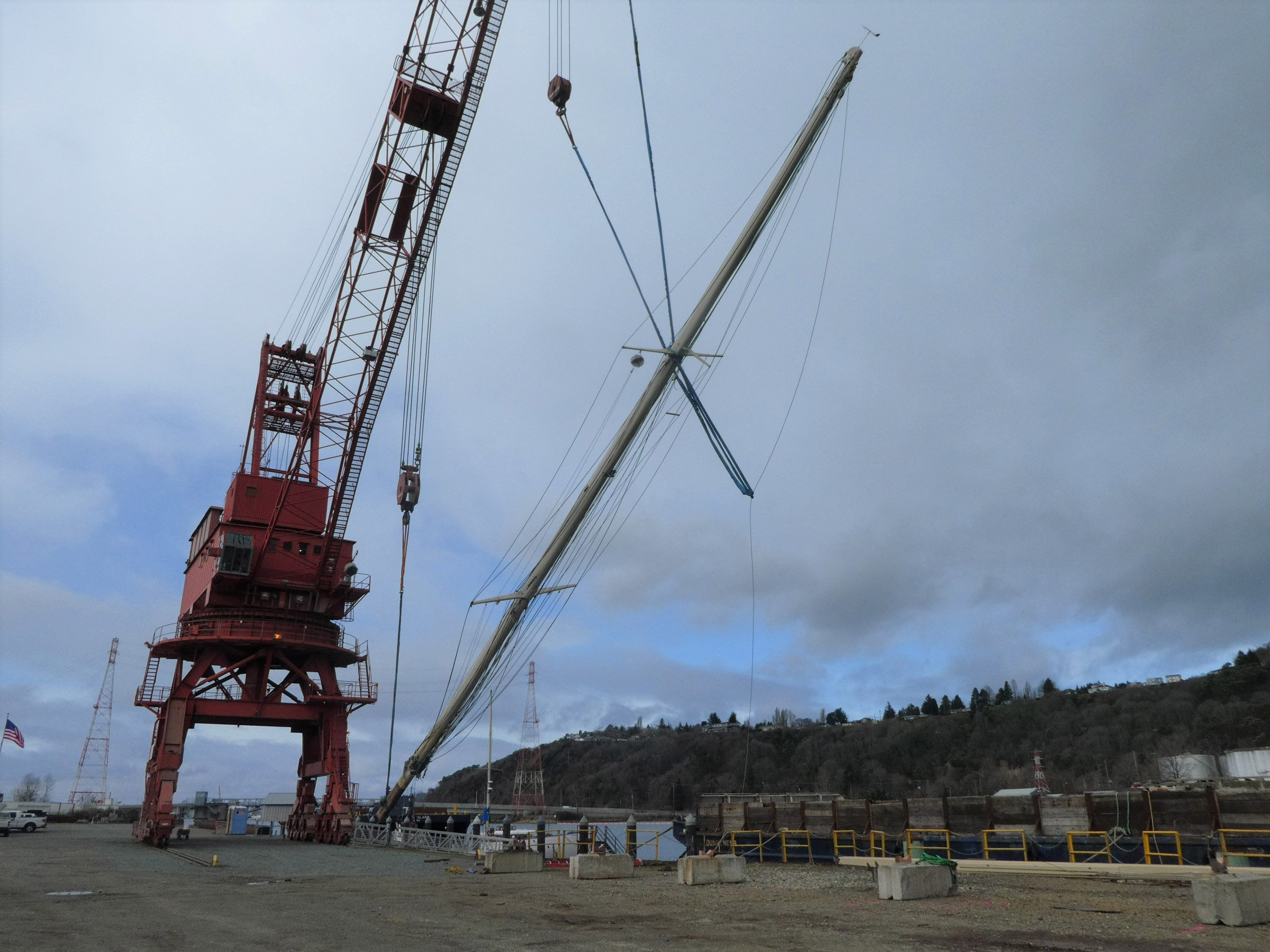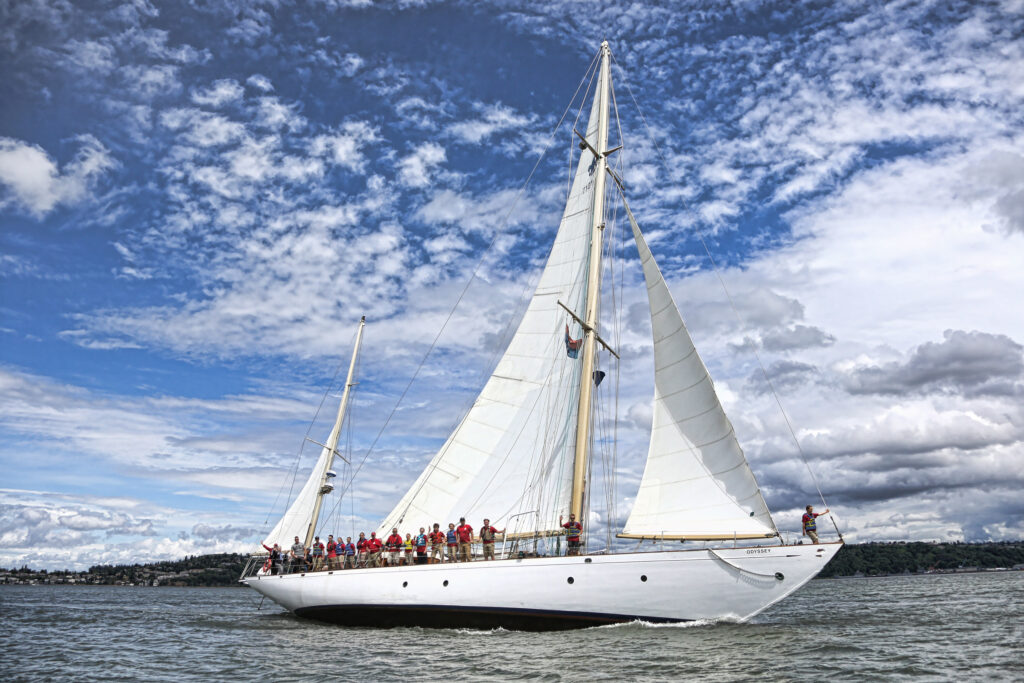
By Emily Molina
It’s been well over a year since anyone’s hoisted the mainsail on the iconic 90-foot-long Tacoma mainstay and Sea Scout Ship 190 (SSS 190) training vessel, Odyssey. That’s due to the fact that in March of 2021 routine maintenance led to the discovery of soft wood near the mainmast-deck intersection, which prompted its removal. When further sections of soft wood were uncovered and workers found that a glue failure resulted in delamination, all parties concluded that replacement of the 105-foot Sitka spruce mast was unavoidable.
Holding fast on the precipice of an illustrious 84-year history that started far from the Northwest in the Nevins Shipyard in New York, it’s now all-hands on deck as Odyssey waits to sail again.
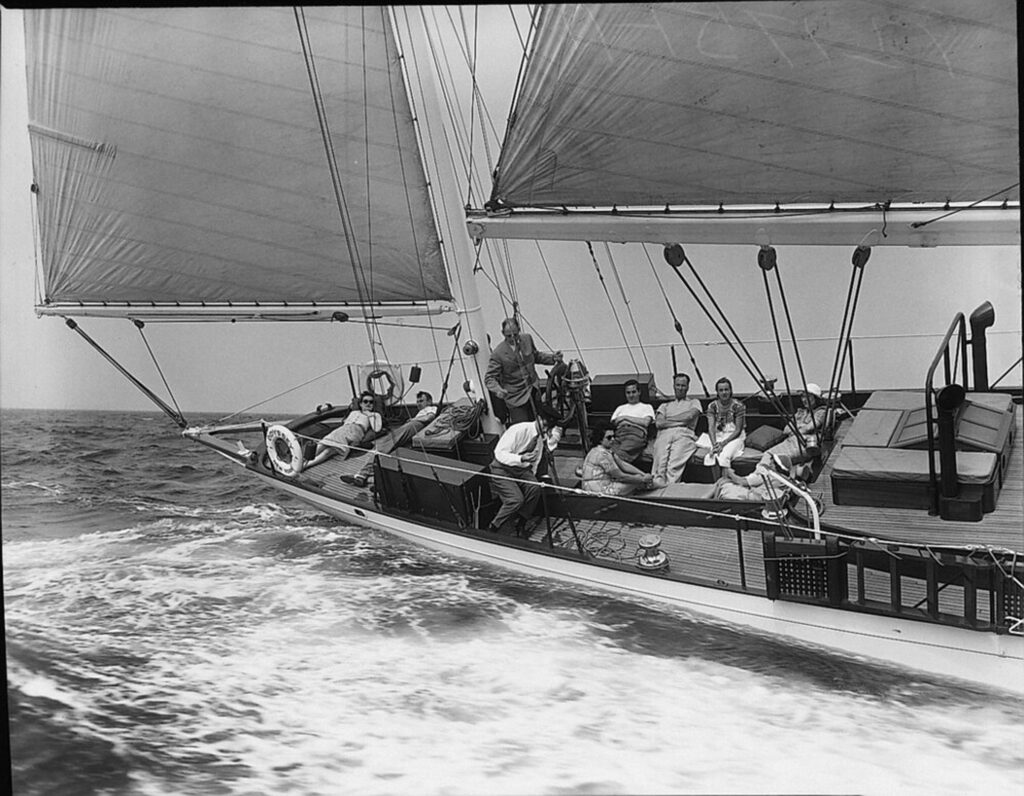
Origin Story, 1938
Originally built for Barbara Whitney, high society daughter of Gertrude Vanderbilt Whitney and Harry Payne Whitney, Odyssey’s story begins all the way back in 1938. The aforementioned Barbara married Barklie McKee Henry in 1924 and later did what any avid sailing wife would do—she bought her husband a sailboat for his birthday.
The new yacht was delivered in the fall of 1938 and her journey set sail. From grand trips to Belize and onward through the Panama Canal, crossing the equator and on to the Galapagos Islands, to sailing and entertaining in the waters off Connecticut and New York, the couple and their two children would spend several years with the yacht before the dawn of WWII.
The Navy Years, 1942-1974
Commandeered by the US Navy in 1942 and leaving her life of luxury behind, the newly renamed USS Saluda IX87 was painted grey, overhauled to diesel, and modified at the U.S. Navy’s Port Everglades base in Florida.
There were three main reasons the navy would want a luxury yacht. First, the plush boat boasted a refrigerator and freezer. “This meant it could carry food for a much longer time than most sailboats,” explains naval architect Bud Bronson, who is also an Odyssey Committee & Organizational Representative and Foss Waterway Seaport Board Member.
“It also had two other features that were extremely rare back then,” continues Bronson. “It had a radio, but it was a voice radio with a radio direction finder, so it could hone in on a signal and tell where the signal was coming from.”
Officially attached to the Bureau of Ordnance in 1943, USS Saluda made its way to the Navy’s Underwater Sound Laboratory at Fort Trumbull in New London, Connecticut. Here, the vessel was engaged in patrolling, testing, and research for the development of early systems used in underwater warfare.
By the time the war ended in 1945, the Henry family would decline the return of their wooden yawl due to weathering sustained during its service, and the ship would remain with the Navy. Briefly sent to the Woods Hole Oceanographic Institute in Massachusetts, Saluda worked in the field of hydrography, a science involving the surveying and measuring of features in and around bodies of water.
By 1947, Saluda would undergo preparations to weigh anchor for the West Coast. For almost thirty years, the ship served the Navy Electronics Lab in San Diego. Participating in underwater sound recording and naval programs involving dolphin training added to Odyssey’s growing resume.
“At one time they had a tank midship, where the two dinghies are now stored, and would carry a couple of dolphins out,” says Bronson. “They put sound gear on the dolphins and they would flip them over the side, monitor them, and then the dolphins would return.”
During this time Saluda was often used for leisure, entertaining, and even racing. In 1950, she even went far as to win the Newport to Ensenada Yacht Race, led by Captain George H. Hanson.
Eventually, the Navy would move on to bigger and fancier equipped boats, while Saluda sailed its way up the coast to Washington. The Whidbey Island Naval Station would be the final destination in what turned out to be a lengthy naval career. It was 1974, and the remaining four years of service were spent mostly as a recreational boat for Navy personnel and the host for many parties. Finally in 1978, in major disrepair and short of funds, the ship parted ways with the Navy.
Odyssey Today, 1974-Through Present Day
Finding someone to take on a wooden sailboat that needed extensive work was no easy task, until it was offered to an individual in Tacoma with ties to the Pacific Harbors Council (formerly known as the Mt. Rainier Council). After countless hours of manpower and funding initiatives to pay for it all, Odyssey was revitalized and relocated to its new home on the Foss Waterway in Tacoma, the ship’s home today.
Today, the boat operates as a Subchapter T vessel according to the regulations of the U.S. Coast Guard. Under the watchful eye of licensed captains at all times, the co-ed Sea Scoutsprogram for ages 14-20 teaches leadership, responsibility, and life skills through tall ship sailing and is an initiative of the Boy Scouts of America. Many youths from across the region, like current ship bosun Anna J., have participated over the years. These experiences have sometimes led students to careers in the maritime industry, but have always provided lifetime worth of memories.
“Sailing on the Sound allows you to experience it in a different way, rather than just observing it,” says Anna, who has been a crew member for five years. “Working on Odyssey has fueled my love of history and respect for sailors of the past. It’s brought me out of my comfort zone, allowing me to gain self-confidence and really mature as a leader.”
The same is true of adult volunteers like Odyssey Committee Chair and licensed Captain Dr. Eric Kiesel, who joined the program in 2007.
“I was a Scout, and I believe in the Scout ideals. It’s a good basis to lead your life on,” says Kiesel. “I really love sailing, and teaching. I want to give the youth a skill set they’ll have the rest of their lives, and one they can enjoy. It also keeps you young.”
The SSS 190 crew is steadfast, showing up every weekend to keep Odyssey in shipshape despite the loss of the mainmast. (Passing its most recent Coast Guard inspection means the vessel is certified to operate by motor without sails.) The Sea Scouts routinely practice man-overboard drills, helmsmanship, navigation, and raising the mizzenmast onboard. The Scouts also participate in small sailboat training, kayaking, skill tests, and other projects.
Saving Odyssey and the SSS 190 Legacy
In the past Odyssey relied on weekend and day sail charters to fund the youth program and the vessel. Trained crew took guests on sailing excursions to places like the San Juan Islands or Victoria, British Columbia. But now, between the lack of a mainmast and the pandemic, it became clear that grave challenges lay ahead. As talks with professional shipwrights with the know-how to restore historic wooden vessels and masts continued, the exorbitant cost of such endeavors hit home.
In December of 2021, a passionate group of individuals got together to start a nonprofit called Friends of Odyssey. Their mission is to gain financial support for the aging vessel, and keep the well-loved SSS 190 program afloat. Founding member, Board President, and former Odyssey Skipper Shana Curd has seen first-hand the positive impacts the program has on young adults, making supporting it all the more vital.
“Boys and girls alike come onboard knowing nothing and learn together as a crew—learning to trust one another,” says Curd. “They’re given adult responsibilities in a supervised environment, a place where they can take risks, be supported, and learn at the same time. It’s amazing to watch their transformation.”
From early days in the epoch of East Coast society to honorable service as USS Saluda during WWII and over three-decades of naval duty to present-day sail training vessel for Sea Scout Ship 190, Odyssey has a long, storied history—and a legacy that her friends are now fighting to preserve for future generations.
>> Help Odyssey sail once again. Funding initiatives are underway for mast replacement, vessel restoration, and sustainability projects, plus any donations made help the organization continue to offer unique youth experiences through the SSS 190 tall ship sailing program. For more information, visit: friendsofodyssey.org. Tax-deductible donations can also be mailed to: Friends of Odyssey: 748 Market Street Unit #91, Tacoma, WA 98402.
About the Author:
Emily Molina is a freelance writer who lives in the South Puget Sound region with her husband and family. A former American Airlines flight attendant and lover of both history and the sea, it is these passions that led her to Odyssey where one of her own children serves on SSS 190 and she volunteers as an adult leader and Friends of Odyssey Vice-President.
